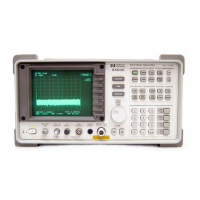Chapter 10 531
Synthesizer Section
Unlocked Reference PLL (600 MHz SAWR)
19.If the loop is unlocked, but signals are present on both inputs of the
phase/frequency detector, the output pulses will be superimposed on
each other.
20.If the loop is unlocked, and there is no signal at one of the
phase/frequency detector inputs, one phase detector output will be at
TTL low and the other will be at TTL high. For example, if there is
no input signal at U504 pin 3, U504 pin 5 will be TTL low and U504
pin 9 will be TTL high. If there is no input signal at U504 pin 11,
U504 pin 9 will be TTL low and U504 pin 5 will be TTL high.
21.To remove the 10 MHz reference input to the phase/frequency
detector, press
AUX CTRL, REAR PANEL, and 10 MHz EXT with no
signal applied to the rear panel 10 MHz REF IN/OUT connector.
22.To remove the divided-down 600 MHz signal from the
phase/frequency detector, short R572. Refer to function block W of
A15 RF schematic.
Check the 600 MHz reference loop amplifier (steps 23-26)
NOTE The outputs of phase/frequency detector are low-pass filtered to reduce
the 10 MHz component of the signal. The filtered signals are then
integrated by U506 and the result is fed to the tune line of the 600 MHz
oscillator.
23.Remove 10 MHz reference input to the phase/frequency detector by
pressing
AUX CTRL, REAR PANEL, and 10 MHz EXT. No signal should
be connected to the rear panel 10 MHz REF IN/OUT connector.
24.Check that the voltage on A15J502 pin 3 is less than 0 Vdc. Refer to
function block P of A15 RF schematic.
Press AUX CTRL, REAR PANEL, and 10 MHz INT and remove the
divided-down 600 MHz input to the phase/frequency detector by
shorting R572.
25.Check that the voltage on A15J502 pin 3 is greater than 5.75 Vdc.
26.Replace C519 in X501.
27.If the loop is locked, the voltage on A15J502 pin 3 should be between
0 V and +5.75 Vdc.
NOTE The 300 MHz CAL OUTPUT signal comes from the divided down 600
MHz which is passed through a leveling loop. The 300 MHz signal
passes through a low-pass filter for reducing higher harmonics. These
harmonics can fool the detector. The 300 MHz signal passes through a
variable attenuator controlled by PIN diode CR503 which is controlled
by the feedback loop. Diode CR504 is the detector diode (the same type
as CR505). Diode CR504 provides temperature compensation between
the reference voltage and the detected RF voltage.

